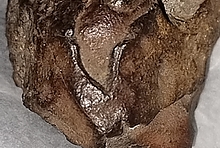Home PageAbout MindatThe Mindat ManualHistory of MindatCopyright StatusWho We AreContact UsAdvertise on Mindat
Donate to MindatCorporate SponsorshipSponsor a PageSponsored PagesMindat AdvertisersAdvertise on Mindat
Learning CenterWhat is a mineral?The most common minerals on earthInformation for EducatorsMindat ArticlesThe ElementsThe Rock H. Currier Digital LibraryGeologic Time
Minerals by PropertiesMinerals by ChemistryAdvanced Locality SearchRandom MineralRandom LocalitySearch by minIDLocalities Near MeSearch ArticlesSearch GlossaryMore Search Options
The Mindat ManualAdd a New PhotoRate PhotosLocality Edit ReportCoordinate Completion ReportAdd Glossary Item
Mining CompaniesStatisticsUsersMineral MuseumsClubs & OrganizationsMineral Shows & EventsThe Mindat DirectoryDevice SettingsThe Mineral Quiz
Photo SearchPhoto GalleriesSearch by ColorNew Photos TodayNew Photos YesterdayMembers' Photo GalleriesPast Photo of the Day GalleryPhotography
╳Discussions
💬 Home🔎 Search📅 LatestGroups
EducationOpen discussion area.Fakes & FraudsOpen discussion area.Field CollectingOpen discussion area.FossilsOpen discussion area.Gems and GemologyOpen discussion area.GeneralOpen discussion area.How to ContributeOpen discussion area.Identity HelpOpen discussion area.Improving Mindat.orgOpen discussion area.LocalitiesOpen discussion area.Lost and Stolen SpecimensOpen discussion area.MarketplaceOpen discussion area.MeteoritesOpen discussion area.Mindat ProductsOpen discussion area.Mineral ExchangesOpen discussion area.Mineral PhotographyOpen discussion area.Mineral ShowsOpen discussion area.Mineralogical ClassificationOpen discussion area.Mineralogy CourseOpen discussion area.MineralsOpen discussion area.Minerals and MuseumsOpen discussion area.PhotosOpen discussion area.Techniques for CollectorsOpen discussion area.The Rock H. Currier Digital LibraryOpen discussion area.UV MineralsOpen discussion area.Recent Images in Discussions
Identity HelpAnother crazy Rawley Mine piece
22nd Mar 2009 02:20 UTCCorie Mattar
At first, I thought gravity had something to do with why the pieces are exactly half-colored, however they are not all half-colored, some are spotted, and they are not in alignment. That is to say, on some the line is horizontal, on others, vertical. Does that make sense?
The specimen consists of galena, and what I originally assumed was quartz. The orange-white pieces scratch quartz however, so its hardness is greater than 7.
No flourescence under high or low, other than the thin coating of calcite on some parts of the piece.
There is one large solid white xl that looks slightly like willemite, however, hardness and lack of florescence seem to preclude that as an ID.
Any ideas?
First pic is the whole specimen, approx 10cm x 10cm by 7-8cm.
Second pic is the white xl, approx 13mm long.
Third pic is a few of the orange-white pieces. Approx 7mm on the largest one.
Thanks for looking!
Corie
22nd Mar 2009 08:32 UTCSebastian Möller Expert
Looks like quartz at all. The orange colour is mostly due to iron bearing inclusions (for example hematite) and/or a thin hematite coating.
Regards,
Sebastian Möller
22nd Mar 2009 08:51 UTCRob Woodside 🌟 Manager
25th Mar 2009 20:22 UTCCorie Mattar
Thanks for the info! I think what threw me was that it scratched a solid quartz XL, yet all the xl did was leave a streak on the quartz.
I know that quartz can be harder or softer that 7 MOHS, I just assumed that a large (6cm) xl would be harder than microcrystalline.
Why would the inclusions settle in exactly half of the quartz, and in only some of the pieces? And those half-pieces are in different directions?
Or is this just one of those mineral mysteries? :S
Thanks again, I really appreciate the info! :)-D
Corie
25th Mar 2009 22:34 UTCRob Woodside 🌟 Manager
26th Mar 2009 04:55 UTCCorie Mattar
Could it have been vanadinite instead of pyrite, though? I'll admit I do not have any pyrite from the same location, but I did recover a specimen with microcrystalline vanadinite, although it was redder.
Thanks, Rob!
Corie
26th Mar 2009 05:13 UTCRob Woodside 🌟 Manager
26th Mar 2009 05:21 UTCCorie Mattar
Corie

26th Mar 2009 07:28 UTCBarry Murphy
I was lucky enough to collect there over a 5 yr period. I'm neither a geologist nor mineralogist, just a collector. Wonderful place for micros!
In all my trips there I never found a piece that contained Pyrite (sorry Rob), BUT there is a ton of Hematite. I'd guess that most of the red country rock around Rowley is stained by it. There is also a LOT of chalcedony, not only in the dumps but scattered aound the country side. That may be what you have there. Any orange or yellow staining is likely due to the massive amount of Mimetite there.
Hope that helps a bit.
Cheers,
Barry M.
28th Mar 2009 01:23 UTCCorie Mattar
I get there every couple years or so. My collecting pal and I got very lucky last time, and there were miners who traded with us and let us collect from the tailings.
We also got some great agates from an area just a mile or two down the road towards the dam. Apparently there is a hill the kids like to 'party' on, and we picked up some beautiful banded agates right out of the tire tracks!
Thanks again for the info,
Corie
28th Mar 2009 08:34 UTCRob Woodside 🌟 Manager




Mindat.org is an outreach project of the Hudson Institute of Mineralogy, a 501(c)(3) not-for-profit organization.
Copyright © mindat.org and the Hudson Institute of Mineralogy 1993-2024, except where stated. Most political location boundaries are © OpenStreetMap contributors. Mindat.org relies on the contributions of thousands of members and supporters. Founded in 2000 by Jolyon Ralph.
Privacy Policy - Terms & Conditions - Contact Us / DMCA issues - Report a bug/vulnerability Current server date and time: April 29, 2024 08:44:41
Copyright © mindat.org and the Hudson Institute of Mineralogy 1993-2024, except where stated. Most political location boundaries are © OpenStreetMap contributors. Mindat.org relies on the contributions of thousands of members and supporters. Founded in 2000 by Jolyon Ralph.
Privacy Policy - Terms & Conditions - Contact Us / DMCA issues - Report a bug/vulnerability Current server date and time: April 29, 2024 08:44:41











